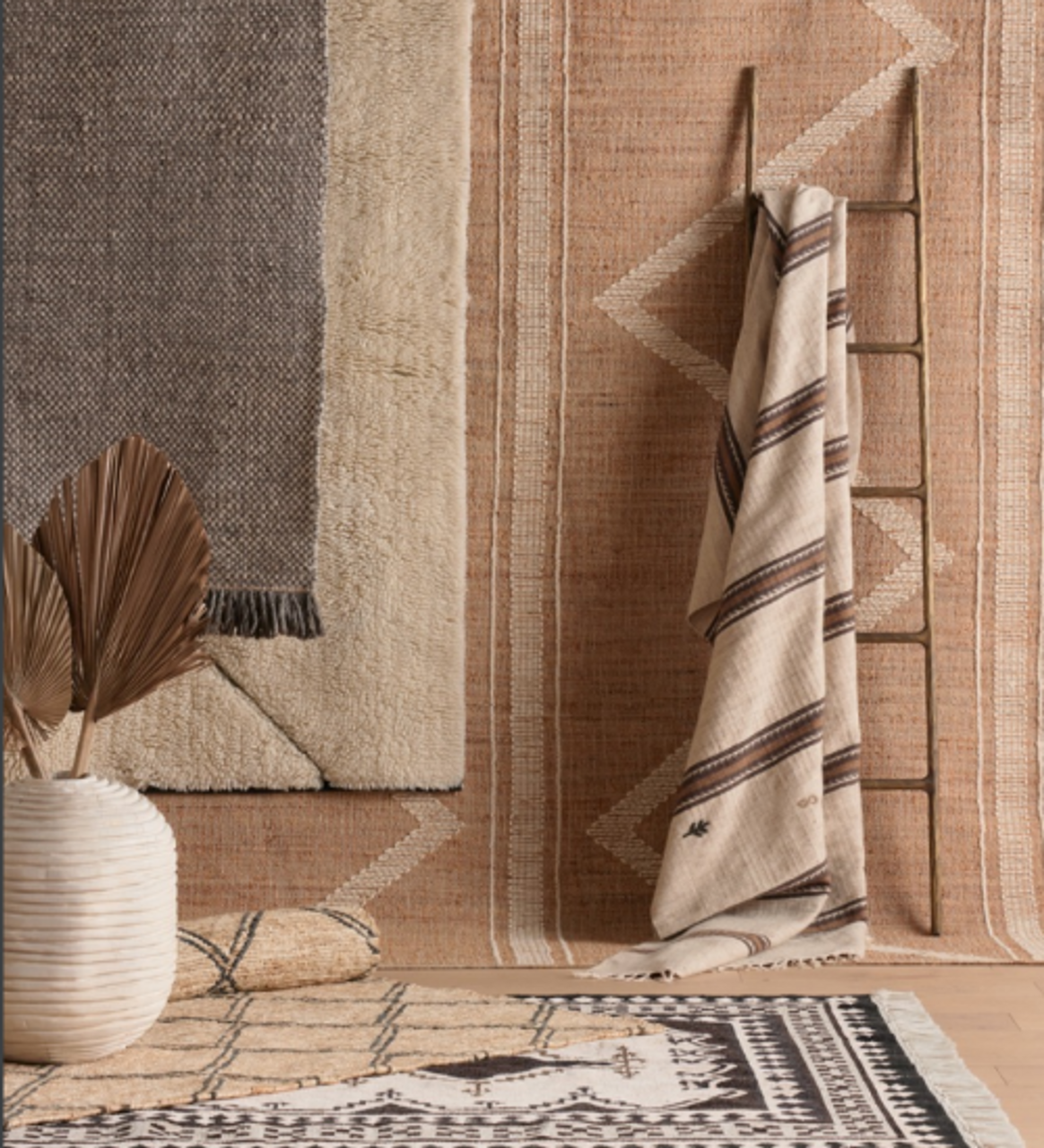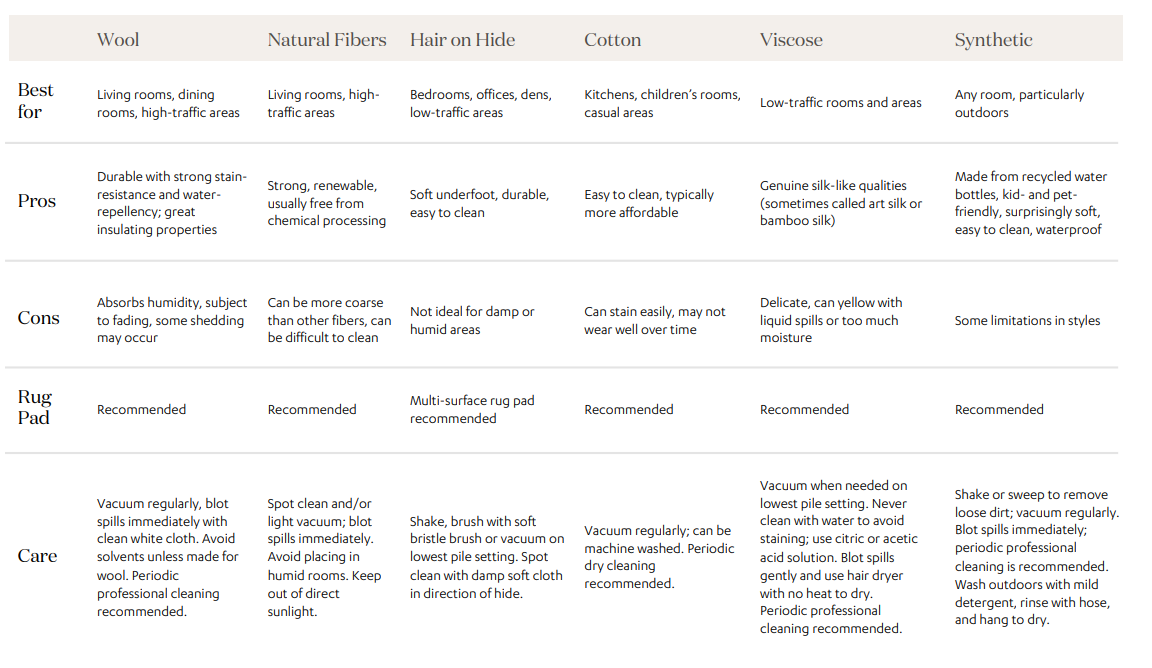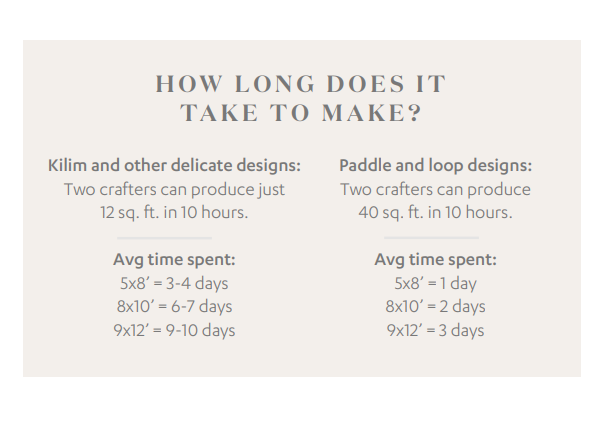The Ultimate Guide on How to Buy a Rug
Posted by Zin Home on 12th Jun 2023
The Ultimate Guide on How to Buy a Rug
Adding the right rug to a room adds a layer of comfort and color that can make any space feel more complete. Our designers introduce new rugs every season in a variety of looks, materials and price points to match any customer, room, style or project.
In this guide, you’ll learn:
- Which materials work best for each room
- How our rugs are constructed
- Which rug types might be a better fit for your project
- How to care for various materials and constructions
Materials & Care
Wool
A natural, renewable resource, wool is also one of the most reused and recyclable fibers in the world. Many of our wool rugs are made from 100% wool gathered from sheep in India. However, some of our wool rugs are blended with other materials, like viscose, to give typically matte wool extra sheen and texture.*
Best for: Living rooms, dining rooms, high-traffic areas
Pros: Durable with strong stain-resistance and water-repellency; great insulating properties
Cons: Absorbs humidity, subject to fading, some initial shedding may occur but will decrease over time
Rug Pad: Optional but recommended
Care: Vacuum regularly, blot spills immediately with clean white cloth. Avoid solvents unless specifically made for wool. Periodic professional cleaning recommended.
Natural Fibers
We offer a range of rugs woven from 100% natural fibers including sisal, jute and seagrass. As always, we never shy away from incorporating mixed materials, such as leather, for even more eye-catching designs.*
Best for: Living rooms, high-traffic areas
Pros: Strong, renewable, usually free from chemical processing
Cons: Can be more coarse than other fibers, can be difficult to clean
Rug Pad: Recommended
Care: Spot clean and/or light vacuum; blot spills immediately. Avoid placing in humid rooms; keep out of direct sunlight.
Hair On Hide
Our 100% hair-on-hide rugs are made from hides that have been upcycled from abattoirs across Argentine Patagonia, England and New Zealand. Each hide is rigorously hand selected for its quality, size and rich color, and finished with a chromium-free tanning process that’s gentler on the environment.
Best for: Bedrooms, offices, dens, low-traffic areas
Pros: Soft underfoot, durable, easy to clean
Cons: Not ideal for damp or humid areas
Rug Pad: Multi-surface rug pad recommended
Care: Shake, brush with soft bristle brush, or vacuum on lowest pile setting. Spot clean with damp soft cloth in direction of hide.
Cotton
Whether spun or woven, our cotton rugs are soft, yet strong and can feature intricate patterns and details due to cotton’s ability to hold dyes well. Wool may also be added to cotton rugs for a more textural look and feel.*
Best for: Kitchens, children’s rooms, casual areas
Pros: Easy to clean, typically more affordable
Cons: Can stain easily, may not wear well over time
Rug Pad: Recommended
Care: Vacuum regularly; can be machine washed. Periodic dry cleaning recommended.
Viscose
Also known as rayon, viscose is a versatile, semi-synthetic material derived from wood pulp, which is treated and spun into yarns. Some of our rugs are made from 100% viscose with the same softness and shine as silk, while others are mixed with wool for added visual interest.*
Best for: Low-traffic rooms and areas
Pros: Genuine silk-like qualities (sometimes called art silk or bamboo silk)
Cons: Delicate, can yellow with liquid spills or too much moisture
Rug Pad: Recommended
Care: Vacuum only when necessary on lowest pile setting. Never clean with water to avoid staining; use citric or acetic acid solution instead. Blot spills gently and use hair dryer with no heat to dry. Periodic professional cleaning recommended.
Synthetic
Made of 100% PET (polyethylene terephthalate) from recycled water bottles, our outdoor rugs are durable, soft, and waterproof, making them a great option for both outdoors and in.
Best for: Any room, particularly outdoors
Pros: Made from recycled water bottles, kid- and pet-friendly, surprisingly soft, easy to clean, waterproof
Cons: Some limitations in styles
Rug Pad: Recommended Care: Shake or sweep to remove loose dirt; vacuum regularly. Blot spills immediately; periodic professional cleaning is recommended. Wash outdoors with mild detergent, rinse with hose, and hang to dry.
DID YOU KNOW? Average water bottlesrecycled per rug size: 5x8’ = 203 8x10’ = 406 9x12’ = 548
Techniques
Hand- Knotted
Known for their durability, hand-knotted rugs can withstand decades of traffic. In fact, they can become more valuable every year and can be handed down for generations. This ancient Indian technique involves artisans looping and securing strands of wool or silk by hand to adjacent knots – producing thousands of knots per rug.
Best for: High-traffic areas
Price point: $$$$
Pros: Extremely durable, rich color, value can increase over time
Cons: Higher price point due to handmade craftsmanship
DID YOU KNOW? Some rugs can have as many as 40 knots per square inch! 9x12’: ~11,000 knots 10x14’: ~17,000 knots
Our hand-knotted rugs can have between 16-40 knots per square inch depending on the intricacy of each design.
Hand-Tufte
Soft, durable and affordable, hand-tufted rugs are made using a handheld tool to stitch yarns onto a sturdy backing that resembles a tightly woven fishnet. Once the pattern is complete, a thicker secondary backing is then attached, which can act as a built-in rug pad.
Best for: Low-traffic areas as plush fibers can lose volume over time
Price point: : $$-$$$
Pros: Sturdy, durable, rug pad is optional
Cons: Some shedding is normal
Hand-Woven
Handwoven rugs, also called hand loomed, can be a more affordable option for more cost-conscious buyers. Yarns on these rugs are woven across each other on a loom.
Best for: Low-traffic areas (guest rooms, offices, sitting areas)
Price point: $$
Pros: Durable; can be produced faster making it more affordable
Cons: Patterns can be limited due to technique (solid, boxes or other geometrical patterns)



